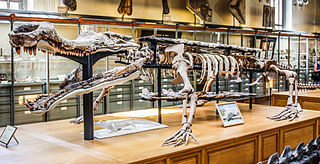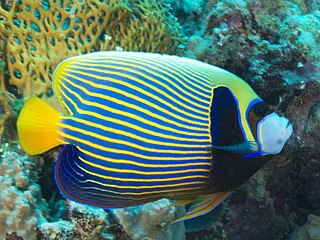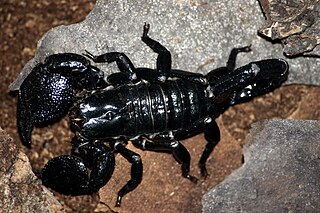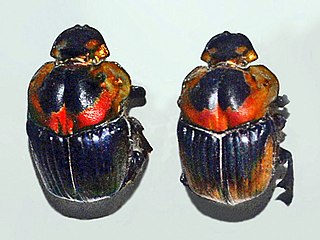
The Callitrichidae are a family of New World monkeys, including marmosets, tamarins, and lion tamarins. At times, this group of animals has been regarded as a subfamily, called the Callitrichinae, of the family Cebidae.

The emperor scorpion, Pandinus imperator, is a species of scorpion native to rainforests and savannas in West Africa. It is one of the largest scorpions in the world and lives for 6–8 years. Its body is black, but like other scorpions it glows pastel green or blue under ultraviolet light. It is a popular species in the pet trade, and is protected by CITES to prevent over-collecting that might impact the species survival.

Sarcosuchus is an extinct genus of crocodyliform and distant relative of living crocodylians that lived during the Early Cretaceous, from the late Hauterivian to the early Albian, 133 to 112 million years ago of what is now Africa and South America. It was one of the largest crocodile-line reptiles, reaching an average estimate of 9 m (30 ft) and 3.45 metric tons, but estimated to grow up to 9.5 m (31 ft) in body length and weigh up to 4.3 metric tons. It is known from two species, S. imperator from the early Albian Elrhaz Formation of Niger and S. hartti from the Late Hauterivian of northeastern Brazil, other material is known from Morocco and Tunisia and possibly Libya and Mali.

The tamarins are squirrel-sized New World monkeys from the family Callitrichidae in the genus Saguinus. They are the first offshoot in the Callitrichidae tree, and therefore are the sister group of a clade formed by the lion tamarins, Goeldi's monkeys and marmosets.

Tapejara is a genus of Brazilian pterosaur from the Cretaceous Period. Tapejara crests consisted of a semicircular crest over the snout, and a bony prong which extended back behind the head.

The emperor angelfish is a species of marine angelfish. It is a reef-associated fish, native to the Indian and Pacific Oceans, from the Red Sea to Hawaii and the Austral Islands. This species is generally associated with stable populations and faces no major threats of extinction. It is a favorite of photographers, artists, and aquarists because of its unique, brilliant pattern of coloration.

The Tropaeum Alpium, is a Roman trophy (tropaeum) celebrating the emperor Augustus's decisive victory over the tribes who populated the Alps. The monument's ruins are in La Turbie (France), a few kilometers from the Principality of Monaco.

Australiceras is an extinct ammonite genus from the upper part of the Early Cretaceous, Aptian stage, included in the family Ancyloceratidae.
Ammonitoceras is an extinct genus of cephalopod belonging to the ammonite subclass that lived during the latter part of the Early Cretaceous in what is now Europe and the transcaspian region. Ammonitoceras was named by Dumas, 1876, the type-species: Ammonitoceras ucetiae. Although the description doesn't mention a hook, as in Ancyloceras or Acrioceras, Ammonitoceras is included in the Ancyloceratidae. However neither do Australiceras or Tropaeum, which are also included.
The king rat is a large species of rodent in the family Muridae. It is endemic to the island of Guadalcanal in the Solomon Islands. Like the two other species of rodent in Guadalcanal, it is placed in the genus Uromys. It lives in trees and is larger than Uromys porculus but smaller than Uromys imperator.

Tupandactylus is a genus of tapejarid pterodactyloid pterosaur from the Early Cretaceous Crato Formation of Brazil.

Boa imperator or Boa constrictor imperator is a large, heavy-bodied, nonvenomous species of snake, of the boa genus, that is commonly kept in captivity. Boa imperator is part of the family Boidae and is found in Mexico, Central America and South America west of the Andes Mountains. It is commonly called the common boa,northern boa, Colombian boa and common northern boa and is frequently and erroneously referred to as the red-tailed boa or Colombian red-tailed boa, especially in the pet trade.

Pandinus is a genus of large scorpions belonging to the family Scorpionidae. It contains one of the most popular pet scorpions, the emperor scorpion . The genus is distributed widely across tropical Africa and the southeastern Arabian Peninsula.

Imperator rhodopurpureus is an inedible fungus of the genus Imperator, found under deciduous trees including oak and beech in neutral soils. Initially described as Boletus rhodopurpureus, it was transferred to the new genus Imperator in 2015. The bolete is considered critically endangered in the Czech Republic.

Anax is a genus of dragonflies in the family Aeshnidae. It includes species such as the emperor dragonfly, Anax imperator.

Imperator torosus, commonly known as the brawny bolete, is a species of bolete fungus in the family Boletaceae. It is native to southern Europe east to the Caucasus and Israel. It is generally associated with deciduous trees such as hornbeam, oak and beech in warm, dry locales. Although generally rare in Europe, it appears to be relatively common in Hungary. Appearing in summer and autumn on chalky soils, the stocky fruit bodies have an ochre cap up to 20 cm (8 in) across, yellow pores on the cap underside, and a wine-red to brown or blackish stipe up to 6–15 cm (2.4–5.9 in) long by 3–6 cm (1.2–2.4 in) wide. The pale yellow flesh changes to different colours when broken or bruised depending on age; younger mushrooms become reddish, and older ones additionally take on bluish tones.

Imperator luteocupreus is a species of bolete fungus in the family Boletaceae. It is native to southern Europe, where it is found under chestnut (Castanea) and oak (Quercus). Although it was originally described in genus Boletus, it was placed in the new genus Imperator in 2015, based on phylogenetic inferences.

Imperator is a genus of fungi in the family Boletaceae. It was circumscribed in 2015 by Boris Assyov and colleagues. The erection of Imperator follows recent molecular studies that outlined a new phylogenetic framework for the Boletaceae.

Sulcophanaeus imperator is a species of beetles belonging to the family Scarabaeidae.

Sulcophanaeus is a genus of beetles belonging to the family Scarabaeidae. This genus has a Neotropical distribution.
















